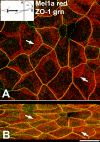Melatonin receptor expression in Xenopus laevis surface corneal epithelium: diurnal rhythm of lateral membrane localization
- PMID: 19936310
- PMCID: PMC2779068
Melatonin receptor expression in Xenopus laevis surface corneal epithelium: diurnal rhythm of lateral membrane localization
Abstract
Purpose: Melatonin receptors are seven-pass G protein-coupled receptors located in many tissues throughout the body, including the corneal epithelium (CE), and relay circadian signals to the target cells. The purpose of this study was to determine more precisely the cellular distribution of the melatonin receptors in the surface cells of the CE of Xenopus laevis, and to examine the relative distribution of melatonin receptor subtype expression at different times during the circadian cycle.
Methods: Cryostat sections and whole corneas of adult Xenopus laevis were processed for immunocytochemistry using antibodies specific for each of the three melatonin receptor subtypes (Mel1a, Mel1b, and Mel1c). For the circadian studies, corneas were obtained from euthanized frogs at 4-h intervals during a 24-h period under a 12 h:12 h light-dark cycle. Double-label immunocytochemistry was performed using a Mel1a antibody in combination with antibodies against Mel1b, Mel1c, or the zonula occludens protein ZO-1. Corneal whole-mount specimens and corneal sections were analyzed by laser-scanning confocal microscopy.
Results: All three melatonin receptor subtypes were expressed on the surface and sub-superficial layer of CE cells, but with different sub-cellular distributions. The Mel1a receptor was highly localized to the lateral plasma membrane of the surface CE, but also displayed cytoplasmic localization at some times of day, especially at night. Mel1c showed a similar pattern of labeling to Mel1a, but there were some distinctive differences, insofar as the Mel1c receptors were usually located immediately basal to the Mel1a receptors. The relative degree of membrane and cytoplasmic labeling of the Mel1c receptor also oscillated during the 24-h period, but was out of phase with the changes that occurred in the Mel1a receptor localization. Furthermore, in the late afternoon time point, the Mel1a and Mel1c receptors were highly co-localized, suggestive of heterodimerization, whereas at other time points, the two receptors were distinctly not co-localized. Double-label immunocytochemistry of Mel1a and ZO-1 demonstrated that the Mel1a receptor was located basal to the tight junctions, on the lateral membrane in very close proximity to the ZO-1 protein.
Conclusions: Mel1a, Mel1b, and Mel1c receptor subtypes are expressed in the lateral plasma membrane of the Xenopus surface CE, at a position in close proximity to the tight junctions that form the corneal diffusion barrier. The very close association of the Mel1a receptors to the ZO-1 peripheral membrane tight junction proteins is suggestive of a potential role for melatonin in influencing the rate of tight junction formation or breakdown. The transient co-localization of Mel1a and Mel1c late in the light period is suggestive of formation of heterodimers that may influence receptor responsiveness and/or activity during specific periods of the day. The dynamic daily changes in melatonin receptor subtype expression and localization in the surface CE supports the concept that melatonin signaling may affect circadian activities of the surface epithelium of the cornea.
Figures











Similar articles
-
Diurnal variation of tight junction integrity associates inversely with matrix metalloproteinase expression in Xenopus laevis corneal epithelium: implications for circadian regulation of homeostatic surface cell desquamation.PLoS One. 2014 Nov 20;9(11):e113810. doi: 10.1371/journal.pone.0113810. eCollection 2014. PLoS One. 2014. PMID: 25412440 Free PMC article.
-
Melatonin receptor expression in the cornea and sclera.Exp Eye Res. 2003 Aug;77(2):219-25. doi: 10.1016/s0014-4835(03)00126-x. Exp Eye Res. 2003. PMID: 12873453
-
Localization of Mel1b melatonin receptor-like immunoreactivity in ocular tissues of Xenopus laevis.Exp Eye Res. 2004 Oct;79(4):585-94. doi: 10.1016/j.exer.2004.07.004. Exp Eye Res. 2004. PMID: 15381042
-
[Structure and function of melatonin receptors].C R Seances Soc Biol Fil. 1998;192(4):659-67. C R Seances Soc Biol Fil. 1998. PMID: 9842470 Review. French.
-
Melatonin receptors: molecular biology of a new family of G protein-coupled receptors.J Biol Rhythms. 1997 Dec;12(6):528-31. doi: 10.1177/074873049701200606. J Biol Rhythms. 1997. PMID: 9406026 Review.
Cited by
-
Sexually dimorphic effects of melatonin on brain arginine vasotocin immunoreactivity in green treefrogs (Hyla cinerea).Brain Behav Evol. 2012;80(3):222-32. doi: 10.1159/000341238. Epub 2012 Aug 17. Brain Behav Evol. 2012. PMID: 22906877 Free PMC article.
-
Melatonin Entrains PER2::LUC Bioluminescence Circadian Rhythm in the Mouse Cornea.Invest Ophthalmol Vis Sci. 2015 Jul;56(8):4753-8. doi: 10.1167/iovs.15-17124. Invest Ophthalmol Vis Sci. 2015. PMID: 26207312 Free PMC article.
-
Diurnal variation of tight junction integrity associates inversely with matrix metalloproteinase expression in Xenopus laevis corneal epithelium: implications for circadian regulation of homeostatic surface cell desquamation.PLoS One. 2014 Nov 20;9(11):e113810. doi: 10.1371/journal.pone.0113810. eCollection 2014. PLoS One. 2014. PMID: 25412440 Free PMC article.
-
The Role and Therapeutic Potential of Melatonin in Degenerative Fundus Diseases: Diabetes Retinopathy and Age-Related Macular Degeneration.Drug Des Devel Ther. 2024 Jun 18;18:2329-2346. doi: 10.2147/DDDT.S471525. eCollection 2024. Drug Des Devel Ther. 2024. PMID: 38911030 Free PMC article. Review.
References
-
- Pandi-Perumal SR, Trakht I, Srinivasan V, Spence DW, Maestroni GJ, Zisapel N, Cardinali DP. Physiological effects of melatonin: role of melatonin receptors and signal transduction pathways. Prog Neurobiol. 2008;85:335–53. - PubMed
-
- Cahill GM, Besharse JC. Light-sensitive melatonin synthesis by Xenopus photoreceptors after destruction of the inner retina. Vis Neurosci. 1992;8:487–90. - PubMed
-
- Guerlotte J, Greve P, Bernard M, Grechez-Cassiau A, Morin F, Collin JP, Voisin P. Hydroxyindole-O-methyltransferase in the chicken retina: immunocytochemical localization and daily rhythm of mRNA. Eur J Neurosci. 1996;8:710–5. - PubMed
-
- Martin XD, Malina HZ, Brennan MC, Hendrickson PH, Lichter PR. The ciliary body--the third organ found to synthesize indoleamines in humans. Eur J Ophthalmol. 1992;2:67–72. - PubMed
-
- Niki T, Hamada T, Ohtomi M, Sakamoto K, Suzuki S, Kako K, Hosoya Y, Horikawa K, Ishida N. The localization of the site of arylalkylamine N-acetyltransferase circadian expression in the photoreceptor cells of mammalian retina. Biochem Biophys Res Commun. 1998;248:115–20. - PubMed
Publication types
MeSH terms
Substances
Grants and funding
LinkOut - more resources
Full Text Sources
